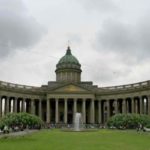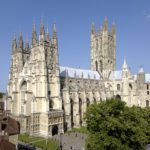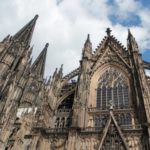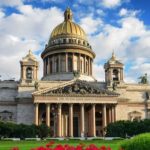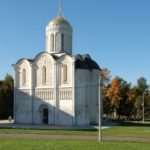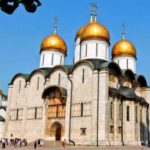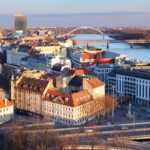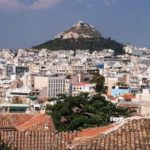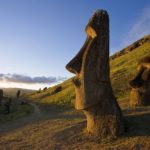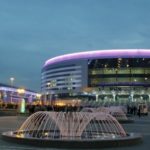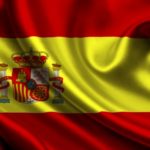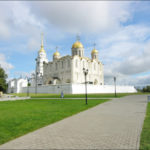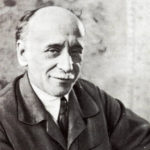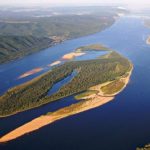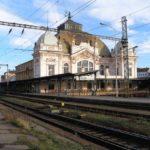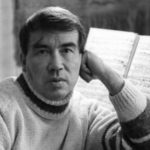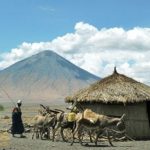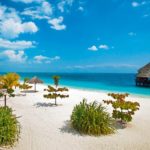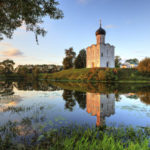Sculptures of Spain
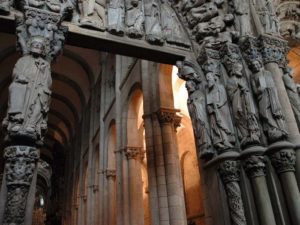 Having traveled not one hundred, or even a thousand kilometers, the pilgrims eagerly expected to see the ultimate goal of the journey. Numerous pilgrimage roads of Europe aspired to the Cathedral of Santiago de Compostela, whose construction began in 1077-1178. The work of the masons, who erected both the cathedral and the sculptures, was led by the “wonderful master” Bernard, who is usually called Bernard the Elder, to distinguish him from the later master Bernard.
Having traveled not one hundred, or even a thousand kilometers, the pilgrims eagerly expected to see the ultimate goal of the journey. Numerous pilgrimage roads of Europe aspired to the Cathedral of Santiago de Compostela, whose construction began in 1077-1178. The work of the masons, who erected both the cathedral and the sculptures, was led by the “wonderful master” Bernard, who is usually called Bernard the Elder, to distinguish him from the later master Bernard.
In addition to the capitals of the interior, representing the adaptation of ancient Corinthian capitals with a leaf ornament, large portals with important sculptural works belong to the Rano-Romano period in Spain. The western portal could not be completed in accordance with the original plan, therefore its modern look reflects the late Romanesque style of Spain. The northern portal of the transept, Puerta de Fransichen, was destroyed in the 18th century. The side portal on the facade of the north wing of the transept, Puerta de Asabacheria, was destroyed by fire during a riot back in 1117. He left only a surprisingly shaped section of the column.
The only surviving portal is the Puerta de las Platerias – The Gate of the Silver Masters, located in the south wing of the transept, during the construction of which some fragments of other portals were used. Two tympana double portal, completed in 1103, collected from different numbers of small plates of different sizes. On the right portal in the center of the lower sculptural group there is a picture of the flogging of Christ, to the left of it there is a wedding with a crown of thorns and healing of the blind, and in the upper sculptural group there is a badly damaged adoration of the Magi. On the left tympanum, consisting of even more heterogeneous plates, the temptation of Christ in the desert is depicted. Most of the reliefs, according to French studies, are made under the great influence of the Cathedral in Conca, although the healing of the blind man in many ways resembles the sculptures of Leon.
The reliefs on the slopes of Puerta de Las Platerias, stretched in width to the buttresses of the pillars and dated to the last decade of the 11th century, formerly could be part of the destroyed portal of Puerta Fransichen. The images of King David playing a musical instrument and the creation of Adam are highly skilled in performance, and the last scene, in which the Creator laid his right hand on Adam’s head to create it in his own image and likeness, radiates simplicity and dignity.
Two portals were built on the south side of the collegiate church of San Isidoro in Leon around 1100: Puerta del Perdon – Gate of Forgiveness; in the south wing of the transept and Puerta del Cordero – The Gate of the Lamb; through which you can enter the temple from the south side of the nave. The Timpan Puerta del Cordero portrays Abraham in great detail, sacrificing Isaac, and much is not mentioned in the Bible — for example, the mule that Isaac rode on, or that he broke off when he reached his goal. The biblical story emphasizes that the son of Abraham voluntarily surrendered himself into the hands of divine providence, having accepted the fate.
One of the details is directly related to the current history of the Christian Reconquista. The two figures on the left are Hagar, the Egyptian maid of Abraham’s wife Sarah, and her son, Abraham, Ishmael, who is called in the book of Genesis “the wild donkey.” They were expelled into the wilderness, because the descendants of Mahomet were called “Ismailis” or “exiles.” Ishmael on horseback and with a turban on his head directs the point of the arrow to the Lamb of God, which is above the scene of Isaac’s offering. This reads the harsh sentence of the Arab world, which is not surprising, since during the creation of the tympanum Spain was swept by the war with the Moors.
The works of the turn of the XI and XII centuries also include two capitals of archivolt, located one opposite the other on the portal of the southern side nave in the Khaki Cathedral. The prophet Balaam and his donkey are depicted on the left capitals, and on the right the scene of Isaac’s sacrifice is shown again. This topic has gained tremendous popularity in the Romanesque art, because it taught humility, humility and acceptance of the fate predetermined by the Lord. This gimp is exceptional in two ways. First, she depicts a sacrifice at the most dramatic moment of his: Isaac stands fearlessly and submissively, ready to sacrifice himself, his hands are tied behind his back, and Abraham is going to commit murder, besides his own son. At that moment, the angel of the Lord stops the sword of Abraham and frees him from making this sacrifice. Secondly, the sculptor refers to the tradition of antique nude figures. Both heroes — Isaac and Abraham — are naked, but the father’s body is draped with a long robe.
Obviously the influence of antiquity in the image of the naked body, although the style remains romance. The example was the work in the cathedral Fromromis. The image of paradise is a direct copy of the ancient tomb of Orestes in the Santa Maria Abbey in Usillos – it is currently in the Prado Museum of Madrid, only the ancient Orestes has turned into the Roman Adam.
